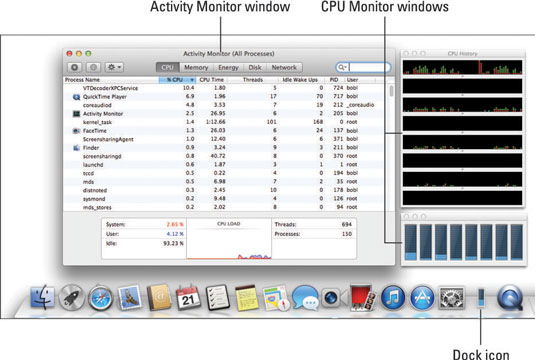How to Use Several Useful Utilities in OS X Mavericks
OS X Mavericks comes with a large number of useful utilities that make using your computer more enjoyable and/or make you more productive when using your computer.
OS X Mavericks Activity Monitor
In Unix, the underlying operating system that runs OS X and the applications and other things that happen behind the scenes are called processes. Each application and the operating system itself can run a number of processes at the same time.

Here you see 78 different processes running, most of them behind the scenes. Note that when this photo was taken, there were six or more programs running, including Finder, FaceTime, the Mac App Store, and Activity Monitor itself.

To display the two CPU Monitor panes on the right side of the Activity Monitor window, choose Window → CPU Usage (keyboard shortcut Command + 2) and CPU log (keyboard shortcut Command + 3).
You can also specify what appears in the Activity Monitor Dock icon — CPU usage, CPU history, network usage, disk activity, or Activity Monitor icon — by choosing View → Dock icon. All but the Activity Monitor icon appear live, which means that they are updated every few seconds to reflect the current situation.
To choose how often these updates occur, choose View → Update Frequency.
But be careful – setting Activity Monitor to refresh more frequently will use more CPU cycles, which can slightly reduce overall performance.
Finally, the bottom of the Activity Monitor window can display one of five screens. Simply click on the appropriate tab – CPU, Memory, Power, Disk, or Network – to see that specific screen.
Since all Macs that can run Mavericks have at least a dual-core processor, you’ll see at least two, possibly four or more CPUs displayed in the Activity Monitor, one for each core.
Geeks and troubleshooters (and even you) can use Activity Monitor to determine which processes are running, who owns the process, and how much CPU and memory the process is using. You can even use this feature to terminate or force termination of a process that you think might be causing you problems.
Messing around with Activity Monitor is not a good idea for most users. If you’re having problems with an app or with OS X, try to quit open apps, force quit apps (press Command + Option + Esc – “three-finger salute” on a Mac), or sign out and sign back in before you start in process manipulation.
AirPort Utility in OS X Mavericks
You use AirPort Utility to set up your AirPort Base Station, AirPort Extreme, AirPort Express, or Time Capsule and configure their individual settings, such as the base station and wireless network passwords, network name, Internet connection type, etc.

When you first open AirPort Utility, select the AirPort Base Station you want to work with by clicking its icon on the left side of the window.
If you want assistance with setting up your base station, just click the Continue button in the bottom-right corner of the AirPort Utility window. You’re asked a series of questions, and your base station is configured accordingly. If you know what you’re doing and want to change your base station’s settings manually, choose Base Station→Manual Setup (Command+L) instead.
ColorSync Utility in OS X Mavericks
ColorSync helps ensure color consistency when you’re scanning, printing, and working with color images. This package includes ColorSync software as well as premade ColorSync profiles for a variety of monitors, scanners, and printers. And the ColorSync Utility has a bunch of tools designed to make working with ColorSync profiles and devices easier.

A ColorSync profile is a set of instructions for a monitor, scanner, or printer, which tells the device how to deal with colors and white so the device’s output is consistent with that of other devices, as determined by the ColorSync profiles of the other devices.
In theory, if two devices have ColorSync profiles, their output (onscreen, on a printed page, or in a scanned image) should match. Put another way, the color that you see onscreen should be exactly the same shade of color that you see on a printed page or in a scanned image.
If you’re not a graphic artist working with color files and calibrating monitors and printers to achieve accurate color matching, you probably don’t need the ColorSync Utility (unless you’ve gotten hooked on iPhoto and want your printed inkjet color pictures to match up correctly).
If you’re compelled to do whatever it takes to get accurate color on your monitor and printer, check out Color Management For Digital Photographers For Dummies, by Ted Padova and Don Mason (Wiley).
DigitalColor Meter in OS X Mavericks
The DigitalColor Meter program displays what’s on your screen as numerical color values, according to two different systems: RGB (red-green-blue) and CIE (the abbreviation for a chromaticity coordinate system developed by the Commission Internationale de l’Eclairage, the international commission on illumination). If you’re not a graphic artist or otherwise involved in the production of high-end color documents, or working in HTML, you’ll probably never need it.
